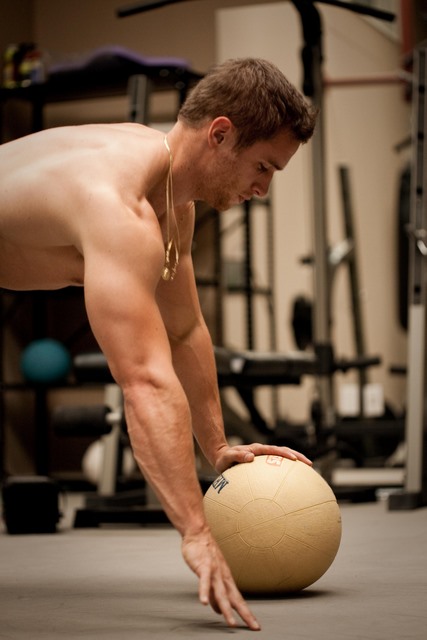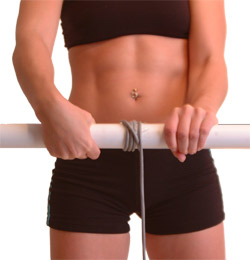
I can’t remember where I read it, but it must have been a Men’s Fitness or Men’s Health article or something. It had a study that said men’s forearms are to women, what a woman’s cleavage is to a man. And it makes sense, kind of…
If a lady has some solid cleavage, men’s eyes will automatically take a peek. It’s not our fault, it’s our eyeballs’ fault. Or it’s a case of the “little head thinking for the big head” as the movie A Bronx Tale put’s it. We’ll at least take a quick glance, it’s inevitable. If we catch ourselves early enough, we’ll avoid looking at it, but that’s a conscious effort to avoid looking, after we’ve already noticed it in the periphery.
Jerry Seinfeld put it best, when talking to George after George had been caught glaring at some cleavage:
“Looking at cleavage is like looking at the sun. You can’t stare at it long, it’s too risky. You get a sense of it then you look away.”
When women look at men, assuming that their forearms are exposed, they don’t have the same struggle of trying to quickly glance – after all, they’re not men. But they notice them.
A solid set of forearms says a lot about a guy; it says that he takes care of himself and that he has pride in how he looks and in his health. Muscular forearms are also associated power and strength. Ladies like to feel protected and safe. Even if you can’t protect yourself from a fly, some solid forearms will at least give you that illusion.
How to Train the Forearm
Forearms can be trained through exercises where there is flexion and extension of the wrist, wrist curls, or static movements like grip exercises where there is no movement of the wrist, or any joint for that matter. I’ve found that a combination of both is the best way to go.
Note: overtraining the forearm can result in soreness in the elbow, so if that begins, focus on static exercises only.
Static Exercises
Whenever you’re gripping a weight, you’re working your forearm. That’s why I’d rather you – and me – stay away from using wrist straps, because you’re not going to see the same strength in your grip, or progress in forearm development.
I always have a rule when I’m lifting, or when I’m training someone: if I can’t lift the weight properly without the use of some kind of equipment, then I’m not strong enough to lift the weight.
Static exercises include any exercise where you’re holding weight. Most notably the deadlift with a hook (overhand) grip. Pulldowns and chin-ups are also great for improving grip strength.
The Farmer’s Walk
This is my favourite grip/forearm exercise. It’s also great for trap and core development. Carry two heavy dumbbells for a determined length. Try and choose a distance that takes at least 30 seconds. If you don’t have a lot of room, go to one end, turn around, and then head back to the other end. Go to failure or to when you absolutely can’t cary the weight any longer.
Throughout the walk make sure to keep your shoulders back, and your back straight. And always sure you squeeze the crap out of the dumbbells!
Contracting Exercises
These are exercises where we’re contracting the muscle. Here are my 3 favourite exercises that involve movement of the wrist (or biceps in one case):
1. Reverse Biceps Curl
The reverse barbell curl primarily works the lower bicep and the back of the forearm (the extensors and the upper part of the brachioradialis – the muscle that meets at the outer elbow and is flexed when the writs is completely extended, or the back of the wrist is flexed).
It’s a great exercise that gives bulk not only to the forearm, but the lower bicep which will help eventuate the muscle. You can substitute the barbell with dumbbells. Always make sure you’re keeping your elbows tucked to your sides.
2. Rope Curl
This is the best of the flexion and extension exercises. Your gym should have the right equipment for you to do this exercise, but if they don’t you can easily make it. Here’s what it looks like:
 Tie a plate (try a 25 lbs plate) to a stick or beam like this. Don’t hold the weight like she does in the picture. Hold it out in front of you, parallel to the ground. The goal is to curl the rope around the bar until the weight touches the bar – you’re shortening the distance between the bar and the plate. You can use an over-handed or underhanded grip.
Tie a plate (try a 25 lbs plate) to a stick or beam like this. Don’t hold the weight like she does in the picture. Hold it out in front of you, parallel to the ground. The goal is to curl the rope around the bar until the weight touches the bar – you’re shortening the distance between the bar and the plate. You can use an over-handed or underhanded grip.
3. Behind-back Wrist Curl
This is the “classic” method of training the forearm where you’re primarily working the wrist flexors (the flexor capris radials and palmerus longus) and the brachioradialis. The brachoradialis can be seen from a supinated or pronated position. In other words, it starts on the inner part of our forearm at the wrist, and connects that the elbow of the outer part of our forearm.
Hold a barbell – with whatever weight you choose – behind your back, curling both wrists (flexion) at the same time. It’s a great way to work ‘the meat’ of the forearm.
Implementacione
I often neglect to isolate the forearm because I’ve always had some pretty good ‘cleavage’. Instead I almost exclusively focus on developing my forearms through static exercises. However, if they’re a muscle that you really need to start developing, add a couple of sets on at the end of a workout twice a week.
Choose any two of the previous exercises and use them in whatever rep and set scheme you’re doing at the time. I prefer to go with a 3 sets of 8-12 with forearm isolation, rather than going too heavy.
What’s your favourite forearm exercise?
Are you STRONG enough to conquer the PowerHowse Challenge?
Find this article helpful? Sign up below for more tips not found on the blog:
